When Tara Monsod met Anthony Sinsay in 2012, she was a new graduate of The Art Institutes in San Diego and had just taken a job in the kitchen of the restaurant Herringbone. Monsod had wanted to cook Asian food, but, she recalled, there weren’t many choices for creating modern Asian cuisine other than at Nobu.
Once at Herringbone — then part of the portfolio of fabric-themed restaurant group Enlightened Hospitality, run by James Brennan and Brian Malarkey — she learned that Sinsay was running the kitchen at sister restaurant Burlap.
“I found out that he was Filipino and that he was passionate about Filipino cuisine and our culture,” recalled Monsod, who is also Filipino American, and is now executive chef at Animae. “I staged for him and did an interview and asked if I could work there instead of Herringbone. And the rest is kind of history.”
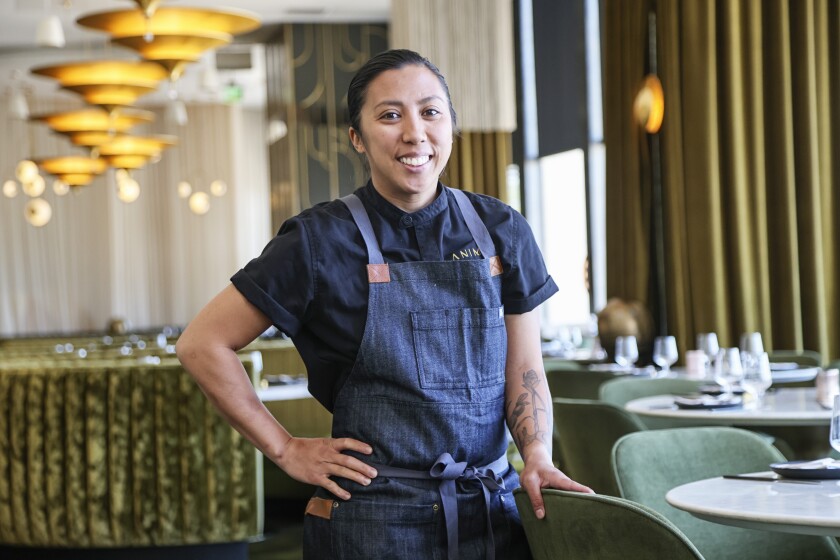
Tara Monsod, now executive chef at Animae in downtown San Diego, was one of chef Anthony Sinsay’s proteges and a close friend. The two chefs shared a bond over their Filipino heritage and worked to showcase the cuisine.
(Eduardo Contreras / The San Diego Union-Tribune)
Monsad moved over to Burlap, where Sinsay mentored her. She considers herself not just one of his proteges but a close friend. In fact, Monsod is one of several Sinsay proteges, “Sinsay’s kids,” who sustain the culinary legacy of the late chef, a San Diego native.
Sinsay died in May after a two-year battle with a rare cancer, a primitive neuroectodermal tumor, that largely strikes children and young adults. He was only 37, married to Elyse, and the dad of two young children.
It would be a cliché to say that Sinsay was passionate about food — but it would be his truth. I, too, had known him since 2012, but I first interviewed him in 2016, when he was executive chef at Duke’s La Jolla. I came away with an understanding of how deeply the food he made was tied to his very existence. He told me he had been cooking most of his life, admitting with a smile that while his mom was no cook, his dad was.
Sinsay said back then that he especially loved waking up to the aromas of Thanksgiving dishes his father prepared from early in the morning for hordes of cousins to eat at midday.
Sinsay spent hours and hours with his dad, watching cooking shows — Julia Child, Martin Yan, Jeff Smith — until his dad, who developed congestive heart failure, died. Sinsay was just 11 years old.
“I remember my dad through cooking,” Sinsay had said with emotion. “After he died, there was no one to cook. My siblings were much older, so when I got home it was my job to make dinner.”
Sinsay’s culinary inspiration came from his dad. But after his father’s death, his mom began exposing him to restaurant dining. “We dined out a lot at places like Mr. A’s,” he said. “By the time I was 15, I knew I wanted to go into culinary.”
Sinsay attended Le Cordon Bleu cooking school in Pasadena, learning the fundamentals of European cuisine. Over the years, however, it became important to him to infuse his dishes with his Filipino heritage. “These are flavors and techniques that come naturally to me,” he told me.
Cooking was how he came to meet Elyse, who also earned her culinary degree at Le Cordon Bleu. No, they didn’t have a “meet cute” there. Instead, they were introduced by chef Amy DiBiase, their mutual friend and Elyse’s boss at the time at The Cosmopolitan Hotel and Restaurant in Old Town.
“Anthony was then manning Harney Sushi down the street,” Elyse Sinsay said. “That was in 2009, 2010. We got married in 2012 in a private little ceremony and we actually went back to work right afterwards. It was Harney’s anniversary celebration that night as well, so Anthony was stuck at work.”
Food, said Elyse, was the foundation that brought them together.
“It was definitely something that never ceased as a conversation up until the very end,” she said. “At some point in time, Anthony and I were having conversations about what kind of chef and man he wanted to be, and that’s when he decided to take the avenue of incorporating his heritage into that. We had just had our son and we were talking about what is it that really makes you happy, that fills your spirit. I think once that question was posed to him, that’s when his food really took a turn, and he started focusing on his heritage. That’s what he wanted to share with the world.”
By the time they had met, Sinsay had served as chef de cuisine at the Platinum Hotel in Las Vegas, as sous chef at the Viceroy in Santa Monica, and as chef at the SLS Hotel Beverly Hills. He was also a certified mixologist and sommelier. When he returned to San Diego, it was to work as executive chef for three years with Harney Sushi in Old Town before joining Enlightened Hospitality in 2012 for two years in the kitchens of Herringbone Los Angeles and Burlap in Del Mar.
Sinsay moved over to Duke’s La Jolla in 2015 and, in 2016, he joined the Kimpton Hotels & Restaurants group, first at Jsix in San Diego’s East Village. In 2018, he relocated with Elyse and their two kids to Seattle, to the hospitality group’s Outlier restaurant.

Evan Cruz, a corporate chef with Cohn Restaurant Group, was a longtime friend and recalls how Sinsay made a point to help students who were trying to get into the industry. The two men started introducing Filipino cuisine to a broader audience years ago.
(John Gastaldo / For The San Diego Union-Tribune)
During his long years cooking in San Diego, he also carved out time to volunteer at organizations like the culinary program at the San Diego Center for Children, teaching resident youth classes, mentoring kids and guest-judging food competitions.
It was also his time in San Diego when he joyfully woke up diners with his Filipino culinary traditions. He and his friend chef Evan Cruz, now a corporate chef with Cohn Restaurant Group, often put together culinary events featuring Filipino flavors. The two, said Cruz, grew up in neighboring communities in southwestern San Diego and had similar friends and backgrounds, including fathers who both served in the Navy.
But as serious and committed as Sinsay was about his cooking and mentoring up-and-coming cooks, his personality was light and often silly.
“The best thing about Anthony was his sense of humor and his jokes,” Cruz said.
Sinsay, a teddy bear of a man who was easy with big smiles and hugs to match, was known as a jokester. Check out the DineLocalSD Facebook page for a hilarious podcast interview in 2017 with him and chef Kat Humphus, moderated by Kelly Orange at Specialty Produce (Season 1, Episode 22). (Note that there is adult language.)
Cruz also remembered the cook who was intent on helping young people, recalling a time when Sinsay invited him to hang out with him and chef Hanis Cavin to do a cooking class for students at Southwest High School.
“A lot of the kids were Filipino and they were looking to get into the industry, wondering if it was something they could do, especially with our culture,” Cruz said. “We always express our love through food.”
The two chefs had started making a point of introducing Filipino cuisine to more mainstream restaurants years ago through events and their own restaurant menus, but as Cruz explained, they didn’t label it as Filipino food “because people don’t understand it.”
In time, they and several other Filipino American chefs in San Diego grew more audacious in this effort, playing off each other to elevate the cuisine. One of my favorite memories of Sinsay’s food is his Mussels Adobo, which he used to make at Burlap. He told me it was inspired by his mom.
“She grew up in the southern part of the Luzon Island in the Philippines,” Sinsay told me. “She made this traditional dish with chicken that would simmer in the adobo sauce. I like making it with mussels, but I had to add sugar to the adobo sauce recipe to compensate for the shortened cooking time. When you cook vinegar a long time it becomes sweet. This dish with mussels cooks so quickly I needed to add a sweetener.”
He made it for me one afternoon at Duke’s, using traditional Filipino ingredients for his adobo sauce — soy sauce, vinegar and water, along with a little sugar. After whipping up the sauce, he sauteed the vegetables — sliced rings of jalapeño and yellow onion, along with minced garlic. Then he added the mussels and the adobo sauce, simmering the mussels in the covered pan until they opened. And then he took the dish to a richer, more seductive level, mixing in coconut cream and butter. That’s it — except for grilled slices of pan de sal rolls for exquisite dunking.
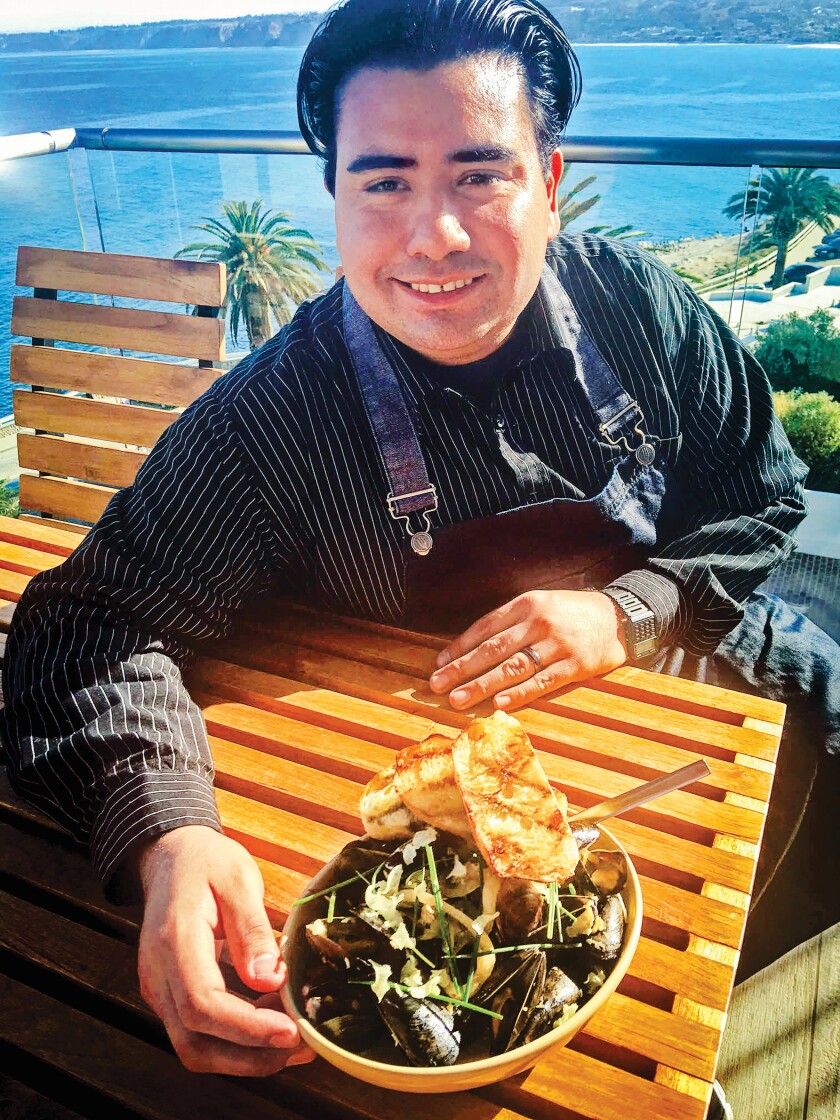
Anthony Sinsay in 2016, with his Mussels Adobo, a dish inspired by one of his mother’s recipes. The chef, who died in May, wanted to ensure his children got a taste of their Filipino heritage.
(Caron Golden)
Many chefs understandably leave their knives and recipes at work. Sinsay, though, loved to cook for his family.
“Food is a huge component of being Filipino,” he told me. “I want my kids to understand that there’s more to life than Happy Meals. I want them to understand where they come from.”
So, for instance, for their birthdays, he would make them pancit, a traditional noodle dish filled with vegetables. On weekends, Elyse said, her husband used to make apple cinnamon doughnuts and French toast with their son, while he and their daughter would make main dishes.
“Our memories are never not involving food,” she said.
Sinsay directed that same enthusiasm for teaching cooking skills and sharing his heritage with the young cooks he mentored.
“I was so eager to learn and started in this industry late — at 27 — after leaving nursing,” recalled Monsod. “I knew deep down that I wanted to cook. Anthony kind of pushed me a little harder. He was always looking at my knife skills. He was on all of us, but I think he and I had a constant connection as far as food. He was a constant motivator, a constant cheerleader pushing me that I could do something when I doubted myself.”
And, years later, still close to Elyse, Monsod has come full circle, running the kitchen at a modern Asian restaurant — another Malarkey restaurant — and adding Filipino-style dishes to the menu. Maybe not Mom’s or Grandma’s traditional dishes, but the flavors are familiar.
“And that’s what he taught me,” said Monsod. “He would say our food doesn’t have to look ugly or be dumbed down. Why can’t it be elevated just like any other Asian cuisine? I knew he was pushing it and pushing it and I was on that train with him.”
What Elyse explained about her husband’s legacy is that he wanted everybody to hold onto the idea that “where you come from, no matter what kind of humble beginning, or whatever kind of seemingly socially unacceptable food or cuisine that your heritage is based off of, that does not negate the beauty and the culinary precision, and the value that it can bring to a community. And never discount where you come from. I feel what Anthony wants everybody to remember is that food is for our souls. And if you’re not allowing your spirit to reach that visceral part within yourself, then you’re really missing out on the best things that not only your gut can experience, but everyone else.
“Anthony was a testament to the idea that the best things in life start from loving and growing and opening up that part of ourselves that makes us curious,” she added. “The way that he lived and the way that he taught and what he would want everybody to remember is whether you are trying to be an executive or if you’re starting out, that no matter what place that you’re at, remember to enter into it and proceed with grace and humility, because there’s always something to gain, and there’s always something to share. And that’s not just with your staff, but that is with your guests, that’s with your family.”
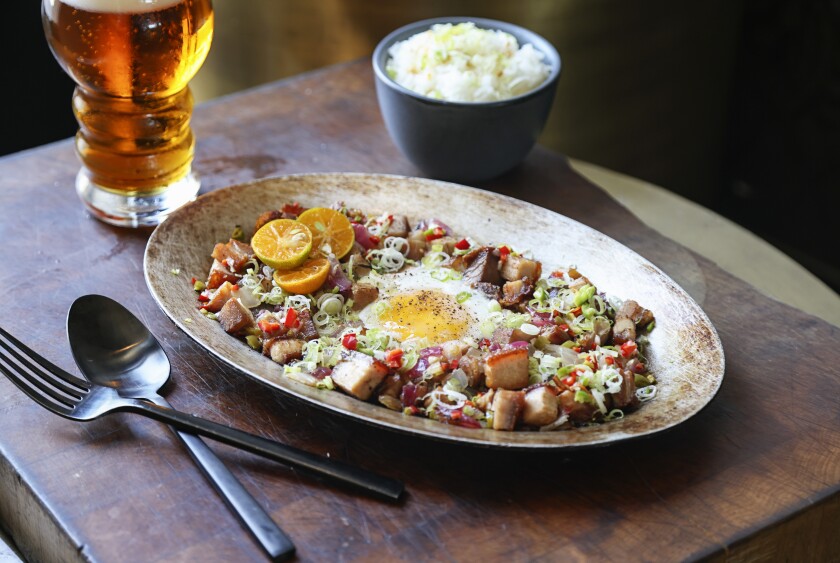
Sisig, a Filipino dish of chopped pork, onions and chiles, prepared by Tara Monsod, executive chef at Animae in San Diego.
(Eduardo Contreras / The San Diego Union-Tribune)
Sisig
In Filipino cuisine, sisig is a rich dish of chopped pork, onions and chiles that gets a touch of acid from calamansi, a citrus that combines the bright flavors of lime and orange. The sauce, said chef Tara Monsod, is like a vinaigrette and doesn’t need to be cooked. Traditionally, the dish is topped with an egg and served on a hot plate. Monsod chose to share her recipe, which uses pork belly, because it brings back memories of Sinsay being her mentor and their shared love for, and pride in, their Filipino cuisine.
Makes 5 to 6 servings
FOR THE PORK BELLY:
2 pounds pork belly, skin on
3 tablespoons Shaoxing cooking wine
¼ cup coarse sea salt
½ teaspoon five-spice powder
½ teaspoon black pepper, ground
Clean the slab of pork belly and lay flat on a large plate with skin facing down. Pour the Shaoxing cooking wine over the pork belly and spread throughout. Then, rub it with ¼ cup coarse sea salt. Ensure that it is well distributed. Rub the five-spice powder and black pepper all over the meat part of the pork belly.
Turn the belly over, skin-side up. Cover and seal using plastic wrap. Refrigerate for 6 to 8 hours. Remove from the fridge. Remove plastic wrap and place skin-side up on a baking rack with aluminum foil on the bottom. Use a sharp tool such as a metal skewer or a knife to puncture skin and fat with small holes.
Heat the oven to 350 degrees and roast the pork belly for 75 to 90 minutes, depending on the pork belly’s thickness. Cook until meat is tender.
Set your oven to broil on high and broil pork belly for 15 to 20 minutes or until the skin gets crispy. Remove from the oven. Let rest for 20 minutes. Then dice into ¼-inch bite-size pieces.
FOR THE SISIG SAUCE:
1 cup distilled vinegar
¼ cup fresh calamansi juice or lemon juice
2 tablespoons minced garlic
1 tablespoon minced shallots
2 tablespoons fish sauce (Monsod recommends Red Boat or Three Crabs brands)
2 tablespoons small dice Fresno chile
2 tablespoons small dice jalapeño chile
Combine all the ingredients in a bowl and mix well. Set aside.
TO ASSEMBLE THE DISH:
1 tablespoon neutral oil (such as canola or grapeseed)
2 cups diced roasted pork belly
Salt and black pepper to taste
¼ cup small dice white or yellow onions
¼ cup small dice red onion
⅓ cup sisig sauce
1 extra-large egg
¼ cup sliced scallions
Place a sizzle platter or small cast-iron pan over medium-high heat. Once hot, add oil, followed by diced pork belly and salt and pepper to taste. Lightly brown pork belly pieces.
Add diced onions and saute for 1 to 2 minutes. Season again with salt and pepper to taste. Pour sisig sauce over mixture and mix well.
Create a shallow well in the center of the mixture. Crack the egg in the well and cook until the white is slightly cooked and yolk is runny. The egg will continue to cook with residual heat.
Turn off heat and garnish with scallions and slices of fresh calamansi or lemon. Serve extra sauce on the side if desired. Serve sizzling at the table and mix the egg with the pork belly mixture. Enjoy with a side of rice.
Recipe from Tara Monsod.
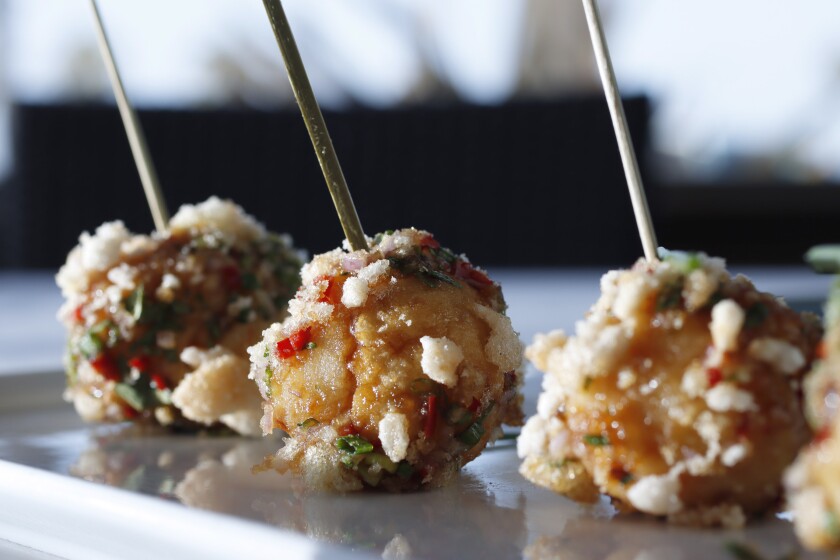
Bola-Bola Shrimp and Fish, a savory snack dipped in a crunchy topping, prepared by chef Evan Cruz.
(John Gastaldo / For The San Diego Union-Tribune)
Bola-Bola Shrimp and Fish
Cruz’s Bola-Bola street food dish is a variation on a dish he and Sinsay once made as the first course or “pulutan” — snacks — for a dinner at JSix. It has four components: the fried shrimp and fish balls, a savory sauce they’re bathed in, and both a chopped herb mix and crunchy topping they’re rolled in. Enjoy as a snack with beer.
Makes 4 servings or 16 small balls
FOR SHRIMP AND FISH BALLS:
8 ounces whitefish (such as sea bass or cod), diced
8 ounces bay shrimp, diced
3 shallots
1 ounce chopped garlic
½ bunch chives, chopped
2 ounces fish sauce (Cruz recommends Three Crabs or Red Boat fish sauce)
1 cup all-purpose flour, as needed
2 cups canola oil, for frying
In a food processor, add whitefish and half of shrimp. First pulse lightly, then blend for 30 seconds. Add shallots, garlic and chives. Pulse again slightly, add fish sauce and pulse again to incorporate. Fold in remainder of diced shrimp.
Lightly dust a cookie sheet with flour and set aside. To make each ball, fill a 1-ounce scoop with the shrimp and fish mixture and drop into a bowl of flour. Cover with flour, remove and place into the palm of your hand. Roll into a ball, and place on the cookie sheet. Repeat until you have 16 balls. Set aside to make the sauce and toppings.
FOR THE SAUCE:
1 cup granulated sugar
1 cup water
3 shallots, diced small
1 ounce Thai chile, diced small
1 ounce chopped garlic
2 ounces fish sauce (Cruz recommends 3 Crabs Fish Sauce or Red Boat)
2 ounces soy sauce
1 ounce apple cider vinegar
3 tablespoons cornstarch slurry (cornstarch thinned with water)
½ bunch chives, chopped
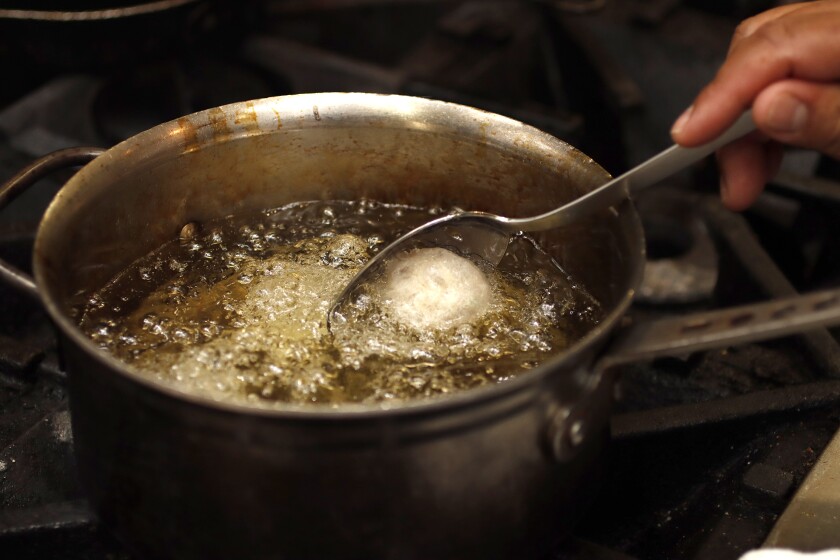
Fry the fish balls in batches until golden brown and floating at the top.
(John Gastaldo / For The San Diego Union-Tribune)
In a small pot, bring sugar and water to a boil, then add shallots, Thai chile and garlic. Turn off to let cool slightly. Mix in fish sauce, soy sauce and apple cider vinegar. Place back on heat, bring to a boil and add cornstarch slurry. Bring mixture back to a boil. When it’s opaque, turn off heat and stir in chives. Set aside.

Chef Evan Cruz finishes assembling the Bola-Bola Shrimp and Fish Balls and coats them in the crunchy pork rinds.
(John Gastaldo / For The San Diego Union-Tribune)
FOR THE TOPPING/COATING:
3 shallots, finely chopped
½ bunch chives, finely chopped
½ bunch cilantro, finely chopped
2 Fresno peppers, seeded and finely chopped
4 ounces shrimp chips, crushed into small pieces
4 ounces pork rinds, crushed into small pieces
Dry the first four ingredients on paper towels and use them to make an herb mixture. Separately, mix the crushed shrimp chips and pork rinds.
To assemble the dish: In a small pot, heat canola oil to 350 degrees, and slowly drop each fish ball in oil in batches, making sure you don’t add too many at once. Fry fish balls until golden brown and floating at the top.
Remove to a paper towel to drain slightly, then dip into sauce to completely cover each fish ball.
Roll the fried and sauced fish balls first into the herb mixture then into shrimp chips mixture. Stick each ball with a bamboo skewer and serve.
Recipe from Evan Cruz.
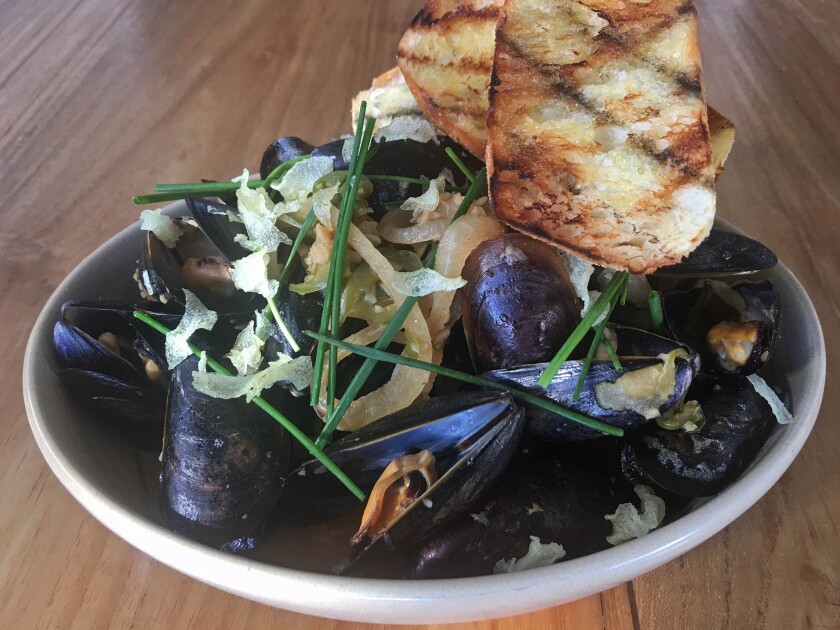
Mussels Adobo, a family recipe from chef Anthony Sinsay.
(Caron Golden)
Mussels Adobo
Adobe is the national dish of the Philippines and varies from region to region. This version is closest to the adobo I grew up with made by my mother from southern Luzon. The sauce is an acidic broth comprised of white distilled vinegar, soy sauce and water. Cooked with onion, garlic and jalapeño balancing sweet, umami, spicy and salty. It’s finished with coconut cream and butter to enrich the flavor and texture. The pan de sal is a Filipino yeast-risen dough with a slight sweet flavor, contrary to what the name suggests. Garnish the mussels with chive spears and crispy garlic chips (slice the garlic thin, blanch, then fry).
Makes 4 servings
3 ounces adobo sauce (see recipe below)
½ ounce of olive and canola oil blend
1 jalapeño, sliced in rings (include seeds if you want more heat)
1 ½ ounces yellow onion, sliced in rings
1 whole peeled garlic clove, minced
9 1½ ounces mussels, cleaned
1 ½ ounces coconut milk
1/2 ounces butter
.1 ounce fresh chives, sliced into 2-inch pieces
1 loaf pan de sal, sliced
Olive oil
FOR ADOBO SAUCE:
¼ cup soy sauce
¼ cup distilled vinegar
1 tablespoon sugar
½ cup water
Make adobo sauce: Combine all ingredients and mix thoroughly until all sugar is dissolved. Set aside.
Sauté the jalapeño, onion and garlic clove in oil. Meanwhile, brush pan de sal slices with olive oil and grill.
Add the mussels to the vegetables and stir together. Add the adobo sauce, stir together, and cover, cooking until the mussels open.
Remove lid and remove mussels from the heat. Stir in coconut cream and butter. Taste the sauce and add salt if necessary to balance the flavor. Garnish with chives and garlic chips (optional). Serve with grilled pan de sal.
Recipe from Anthony Sinsay.
Golden is a San Diego freelance food writer and blogger.






